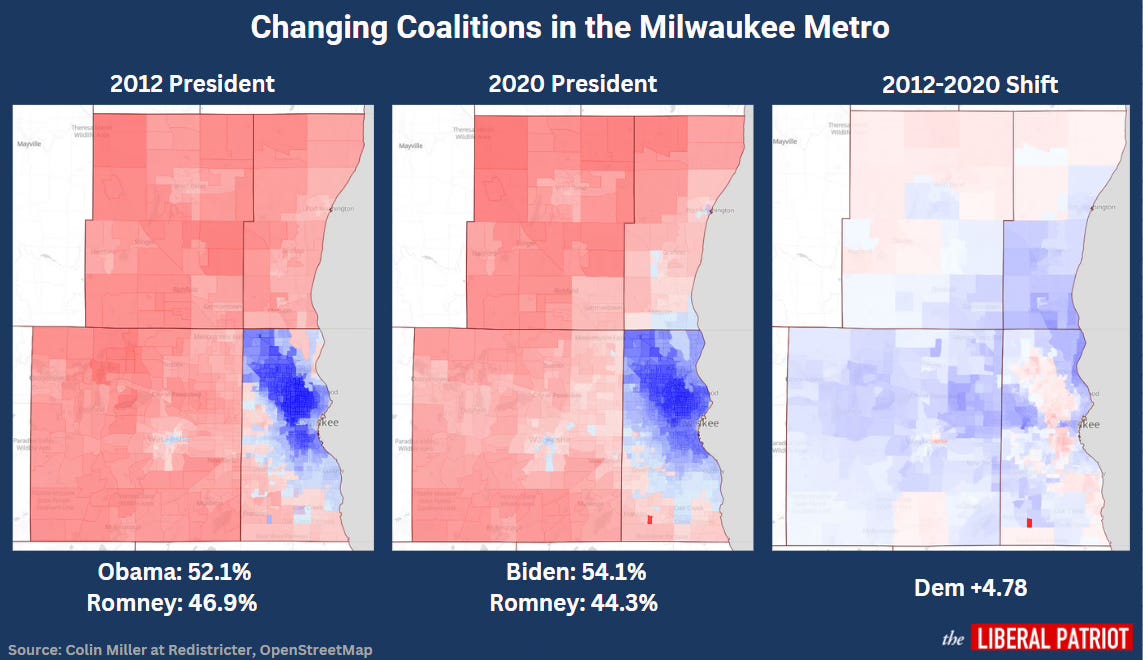The RNC’s decision to host this week’s convention in Milwaukee turned out to be a sharp electoral move. Though voted upon over two years ago, the selection slots perfectly into Donald Trump’s now-clear path towards 270 electoral votes. The Sunbelt states of Arizona, Nevada, Georgia, and North Carolina all lean red, leaving the former president at 268. The Biden campaign, for their part, has recognized that their “clearest pathway” to 270 is through the Midwest—an admission that they, too, think the Sunbelt is slipping out of reach.
But while Biden would have to sweep Wisconsin, Michigan, and Pennsylvania, Trump needs just one to reclaim the White House, should patterns hold. The Badger State may well be his best bet. The tipping point state in 2020, Wisconsin went for Biden by just 20,000 votes, a smaller margin than the 80,000 in Pennsylvania and 154,000 in Michigan. And no area is as crucial to that narrow margin as Milwaukee and its surrounding suburbs.
In 2012, Barack Obama carried Milwaukee and its collar counties—Waukesha, Ozaukee, and Washington—by just over 5 points, buoyed largely by massive margins within city limits. Some Milwaukee precincts didn’t cast a single vote for Romney. But in the “WOW” counties Romney ran up the margin, winning nearly every precinct and netting more than 130,000 votes.
By 2020, as with much of the country, the Democratic coalition had spread into the suburbs. Biden significantly improved on Obama’s numbers, particularly in eastern Waukesha and southern Ozaukee. The town of Mequon, for example, shifted nearly 30 points to the left. But despite this flood of white, college-educated voters into the Democratic Party, the Milwaukee metro as a whole shifted just five points to the left.
Counteracting this dramatic suburban shift was a rightward swing among Milwaukee’s black and Hispanic populations. Compare the 2012-2020 shift map above to the race and ethnicity map below—a near perfect overlap between a red swing and majority-minority neighborhoods (the most Democratic shifts, as expected, map onto the precincts with high educational attainment).
Though the city remains deep blue, gone are the 100 percent Democratic precincts. Trump has clearly gained with Wisconsin’s non-college nonwhite population, but more striking is the raw-vote decrease on the Democratic side. Biden earned 32,000 fewer votes in Milwaukee than Obama as turnout dropped from 66.4 percent to 57.2 percent. Even compared to 2016, Milwaukee’s turnout was flat despite a sizable nationwide increase.
Another pro-GOP shift in Milwaukee looks likely this year. Biden is on track to lose more ground with black and Hispanic voters. And, as enthusiasm for the octogenarian remains low, Trump may erase a chunk of Biden’s 2020 Milwaukee margin simply because Democrats stay home. On the other hand, the high-turnout collar counties have raced to the left each time Trump has been on the ballot, not to mention a Trump-Vance ticket is hardly tailor made to win back suburbanites.
Which of these competing forces prevails might well determine who wins Wisconsin—and the presidency.







